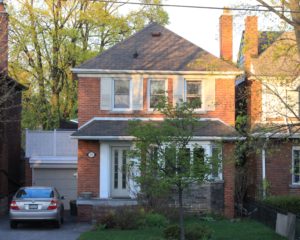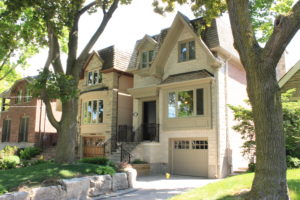June 4:
Anthropomorphise: to attribute human characteristics to gods, animals and inanimate objects.
People have been doing it for years so I know that I am not alone. Pets are given names and welcomed into the family. Those names often reflect character traits we determine by assigning human values to their behaviours. Most of my cars and motorcycles have had distinct personalities. I’ve had my Honda VFR motorcycle for 15 years and I talk to it like a respected old friend. The Benzes were quiet and dignified, the Alfas energetic and outgoing. When special effort was needed, I urged them on as if they could really hear, and when they broke down I cursed them. We all do it.
 After recently writing about Leaside, I’ve been thinking more about the character of houses. Many of the houses are almost 100 years old, and like senior citizens, they portray a calm and respectable dignity. There’s a consistency to their size and appearance that makes them comfortable with each other. When I worked with architects, I often heard them allude to a “conversation” between buildings, and although they didn’t mean it literally, I think it nicely captures the interplay between houses that we feel in our neighbourhoods.
After recently writing about Leaside, I’ve been thinking more about the character of houses. Many of the houses are almost 100 years old, and like senior citizens, they portray a calm and respectable dignity. There’s a consistency to their size and appearance that makes them comfortable with each other. When I worked with architects, I often heard them allude to a “conversation” between buildings, and although they didn’t mean it literally, I think it nicely captures the interplay between houses that we feel in our neighbourhoods.
Like groups of people, neighbourhoods have different personalities. Long Branch is an older area; many of the houses were cottages outside the city. There’s a real mix of scale and building materials that makes it funky and vibrant. The conversation there is like a cocktail party with a mix of guests. Cabbagetown, where I lived for 2 years, is much older and has a completely different scale and texture. Brick Victorians and row housing makes it feel tighter and more enclosed. These guys have seen it all and they can tell you a really interesting story if you are prepared to listen.
Lately in Leaside there has been a rash of demolitions and rebuilding. Having a power shovel appear on your front lawn must be the house-equivalent of terminal cancer in humans; you know that you are about to die, you just don’t know when. I often hear those houses saying: “No wait. There must be some mistake….”
I do not understand the attraction of a larger house – at least, larger than a standard Leaside 3 bedroom, 2 bath house. And I struggle with the concept of demolishing a perfectly serviceable home and essentially throwing it in the garbage, only to replace it with something new. New homes are often designed to mimic older homes. This is in part due to zoning that regulates the height and setbacks, and it might also be a genuine desire on the part of the new kid to “fit in”. The trouble is that most of the newer homes try to affect permanence and solidity with faux stone and stucco; it doesn’t work. I might be more comfortable with the loss of a still-useful and comfortable home if the replacement was a well-thought-out and distinctly designed asset to the neighbourhood, but most of them use the same design and same layout and same building materials and so they come off as lame repetitive imitations.
mimic older homes. This is in part due to zoning that regulates the height and setbacks, and it might also be a genuine desire on the part of the new kid to “fit in”. The trouble is that most of the newer homes try to affect permanence and solidity with faux stone and stucco; it doesn’t work. I might be more comfortable with the loss of a still-useful and comfortable home if the replacement was a well-thought-out and distinctly designed asset to the neighbourhood, but most of them use the same design and same layout and same building materials and so they come off as lame repetitive imitations.
At night, when it’s dark and quiet, I imagine the houses chatting about the day just passed. If a neighbourhood is a conversation among homes, what voice do the newcomers bring ? What do these homes say about the values and beliefs of their owners ? What will they be saying in 100 years ?